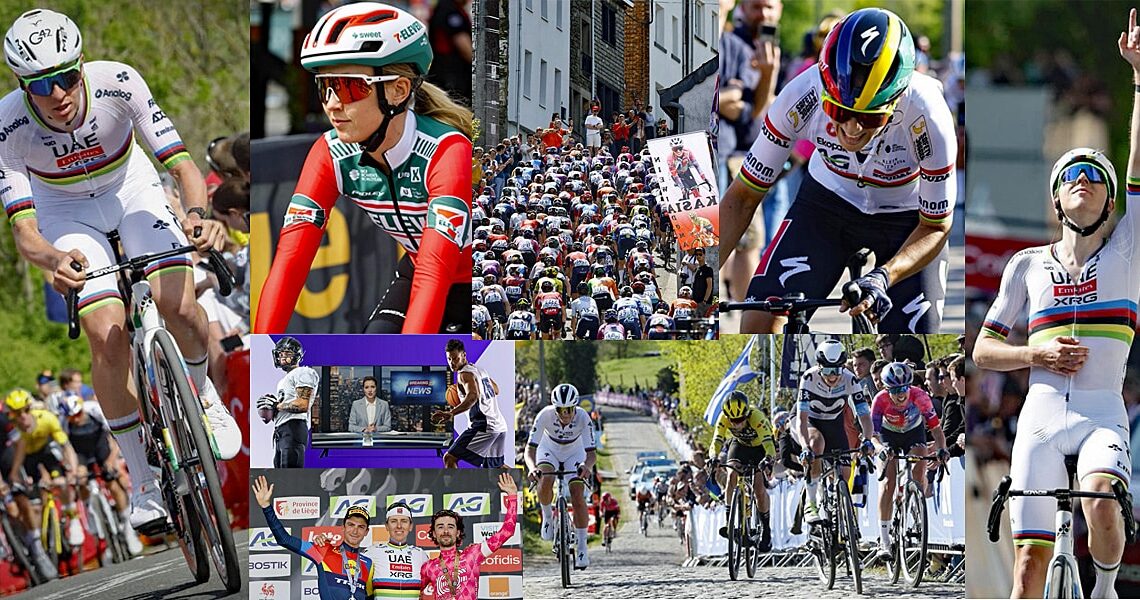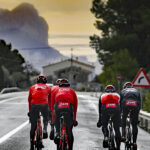
In this week’s AIRmail newsletter, The Outer Line takes an in-depth look at trending cycling news: Tadej Pogačar continues to dominate, “The Athletic” weighs in on cycling, Uno-X’s clever jersey, the excitement of women’s racing, cycling TV is stuck in the past …
# Catch up on pro cycling – and its context within the broader world of sports – with AIRmail … Analysis, Insight and Reflections from The Outer Line. You can subscribe to AIRmail here, and check out The Outer Line’s extensive library of articles on the governance and economics of cycling here. #
Key Takeaways:
- All Pogačar, All the Time
- NY Times: The Reality Facing Cycling
- Uno-X’s Clever Use of the 7-Eleven Jersey
- Women’s Cycling is Much More Exciting at the Moment
- Cycling’s TV Coverage and Technologies are Stuck in the Past

Liège win for Pogačar
With the case for the sport’s top current rider being litigated by Tadej Pogačar, the World Champion continued enforcing the law during the Ardennes Week. His definitive quest to become the top one-day rider in cycling history included winning both Flèche Wallonne and Liège-Bastogne-Liège after finishing second at Amstel Gold. Pogačar and his UAE teammates have distilled challenging one-day races down to a science, and he is undefeated in races with more than 3,500 meters of climbing for almost three years now – ever since the 2022 World Championships. The basic outline of this science is setting an all-day hard pace that fatigues his key rivals before Pogačar’s signature and devastating winning attacks; this approach is delivering wins at a staggering pace that may soon put Eddy Merckx’s record of 19 Monument wins within reach. Pogačar now has nine career Monument wins after his win on Sunday, the most amongst active riders, and tied for third all-time just five years after his first Monument victory. And he is on pace to pass Merckx by the end of the 2030 season, by averaging 1.8 Monument wins a season since taking his first at the 2021 edition of L-B-L. If we consider the fact that he is now virtually guaranteed two Monuments per season – just by showing up to Liège and Lombardia – the eventual catch could come sooner.

World champ dominance of the Classics
One of the most shocking things about Pogačar’s one-day dominance is that it is happening concurrently with Mathieu van der Poel’s nearly equivalent historic win rate. This has seen the sport contract from what we formerly referred to as the “Big Six” down to a duopoly; does anyone consider Wout Van Aert or Primož Roglič to be a top-shelf classics contender now? Van der Poel or Pogačar have won 13 out of the last 15 Monuments (with one of the two non-wins coming after Van der Poel provided a lead-out for his teammate Jasper Philipsen). This has caused a significant squeeze on the other incredible talents who simply have the misfortune of competing at the same time; it brings to mind Phil Mickelson and various other top-notch golfers who had the challenge of competing with Tiger Woods at his prime. In effect, the rest of the peloton is racing for podium spots. When Ben Healy and Giulio Ciccone crossed the finish line a minute behind Pogačar on Sunday, it is likely that both were ecstatic with the result; it was Healy’s first career Monument podium and the best result Ciccone has ever racked up in a WorldTour one-day race.

Tadej Pogačar: The first rider ever to finish on the podium in six straight Monuments
Even the New York Times’ sports unit – The Athletic – got into the Pogačar act, posting a rare cycling article after his win – and questioning what his recent run of dominance means for the future of cycling. With his victory on Sunday, he became the first man in history to finish on the podium in six straight Monuments. He also became just the third person to do the Fleche Wallone-LBL double while wearing the rainbow jersey of the world champion. Pog’s ability to put considerable time into his top opponents, seemingly at ease, “underscores the reality facing cycling,” wrote the Times. Only two or three riders are currently capable of challenging him – Van der Poel on the flats, and Vingegaard in the mountains, with Evenepoel occasionally showing up. Historically, the article points out, one of cycling’s “greatest assets has been the variety of its champions” but now “the flowers invariably fall at the feet of one unassuming Slovenian.” The article goes on to say that even though Pog’s aggressive racing style and off-road personality makes him a widely-liked competitor, dominance in sports can eventually be “exasperating.” However, there is widespread agreement that Pogačar’s legacy “will sit alongside Merckx – and possibly even exceed it.”

Ingvild Gaskjenn of Uno-X Mobility/7-Eleven
Despite Pogačar’s heroics, much of the audience buzz on Sunday revolved around second-division Uno-X racing in throwback jerseys that paid homage to the much-beloved American 7-Eleven team of the 1980s. While the move may have tugged at the heartstrings of nostalgic cycling fans, if we look closer, it was a well-executed navigation of the UCI’s jersey rules, which allows for three temporary jersey designs per season. It allowed the team to maximize the exposure for Uno-X’s parent company, Reitan Convenience, which happens to own both the Uno-X and 7-Eleven brands in Norway. The success of this clever campaign should open the eyes of other existing team sponsors who have multiple brands nested under their corporate umbrella and give teams a new avenue to recruit potential sponsors with multiple brands under a single holding company.

The women’s Liège went to Kim Le Court from Mauritius
In stark contrast to Pogačar’s predictable Liege storming, the women’s race was a chaotic lightning storm of attacks, counters, and brilliant teamwork that led to a dark horse winner. Kim Le Court – from the tiny East African island of Mauritius and riding for the AG Insurance-Soudal team – profited from excellent teamwork and a nose for the right wheels to become a pivotal cog in the the race’s final breakaway along with the much heavily favored Demi Vollering (FDJ) and Puck Pieterse (Fenix). The race which unfolded was everything the men’s race wasn’t: planned tactical risks, improvised alliances, and many of the race’s favorites faltering over the distance and severity of the parcours, making the winning move even more exciting. Le Court’s powerful sprint was straight as an arrow and never in doubt, with Vollering fading to third and Pieterse confirming her Fleche-Wallonne winning form with a strong second place. If “report cards” were due this weekend to grade the women’s season so far, the Women’s WorldTour scored a solid A+ across the board, with exciting editions of each spring one-day race and Le Court acing the midterm exam with flying colors.

The fans were out to watch the women’s Liège-Bastogne-Liège
Women’s sports in general have been on a massive popularity and financial upswing, led by banner editions of the soccer World Cup, the emergence of a new women’s professional hockey league, and new collective bargaining agreements and media rights wins for NWSL soccer and WNBA basketball. An interesting anecdote concerning the WNBA’s growth flew under the radar last week that bears importance for the future of the Women’s WT and its stakeholder decisions. A key moment of the WNBA’s evolution occurred when a global sponsor intervened directly with the league’s executive office to demand more games on the schedule as a condition of its long-term backing. This had two effects: the schedule increase provided more opportunities for the sponsor to reach its target demographics in key broadcast markets, and it increased the overall value of the league’s television market presence. This trend could also represent a landmark moment in women’s pro cycling – but the question remains: can the sport effectively position the WWT broadcast product for the appropriate target demographics and market, as opposed to the legacy men’s cycling’s market and demographics? The right steering adjustments – in terms of how a women’s sport is presented, broadcast, and marketed to sponsors – could accelerate growth for the entire sport.

All women’s sports on the way up
Hence, the topic of race coverage has come up again as we transition from the springtime Monuments to our first grand tours. We noted the rise in pirate streams for races that would otherwise require a subscription service like MAX or TNT Sports to access. A recent short post by our colleague Daam Van Reeth highlights a reason that may be contributing to the trend: a lack of live tracking and other dynamic presentation cues that enlivens the product for new audiences. We’ve also noted this in prior articles, as far back as ten (!) years ago, but the cumulative effect of coverage that lacks comprehensible metrics and consistent real-time multi-frame video feeds is product stagnation. The broadcast production for how “professional cycling races are covered still very much remains the same as in the previous century,” Van Reeth mused, as it still centers on rotating shots from the front of the race by helicopter and motorbike, but with scant information on key rider placement – even though this technology is widely available and used in many amateur road running events. Will in-car cameras make a comeback? Can broadcasters and organizers settle on race metrics that make sense not just to seasoned fans, but also first-time viewers? One thing is certain: if the coverage being sold to fans isn’t easily accessible or adding value, the trend towards refusing to pay for it will likely accelerate. Unfortunately, this seems to be just one more area where cycling’s top leadership is not taking advantage of widely-existing technology, or other innovative approaches to promote the success of the sport.

Cycling on TV
However, the turbulent seas of the broadcast market may not be a magical cure for what ails pro cycling – at least in the short-term. One of the U.S.’s most important content distributors, Comcast, recently reported first quarter financial performance losses, including the loss of 427,000 cable TV subscribers and a surprising loss of almost 200,000 streaming subscribers. These losses underscore what many thought was a drastic decision by the broadcaster last fall to spin off most of its studio portfolio, including MSNBC, USA Networks, and the Golf Channel into a separate entity. But the glue holding the core of Comcast’s business together is proving to be live sports – both its immediate effect of retaining current subscribers, and ability to attract new subscribers through exclusivity of key games, events, and entire league packages. In an investor relations call, Comcast’s chairman summarized its 2026 sports trifecta value in light of the current downturn. “We broadcast the Super Bowl, the Winter Olympics right at the same time, and the World Cup, which puts us in a very enviable position.” Hence, sports have become an ever-more critical product for broadcast powerhouses globally. Pro cycling can thrive in this new marketplace, but only if it balances the risks of exclusivity (direct monetization) against the need for free-to-air programming (gaining new fans), and potential co-branding and partnerships with existing and globally popular league sports to expand visibility and market opportunities. The sport has a lot to do in this regard, and we hope that current leadership will take this challenge by the horns.

Comcast
# Catch up on pro cycling – and its context within the broader world of sports – with AIRmail … Analysis, Insight and Reflections from The Outer Line. You can subscribe to AIRmail here, and check out The Outer Line’s extensive library of articles on the governance and economics of cycling here. #
The post Pogačar Dominates, ‘The Athletic’ Weighs in on Cycling, Uno-X’s Jersey, Women’s Racing & Cycling TV appeared first on PezCycling News.




